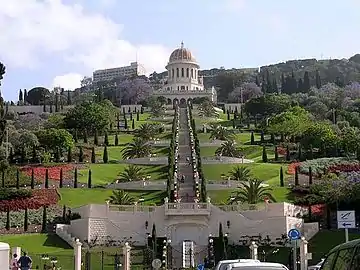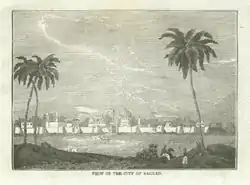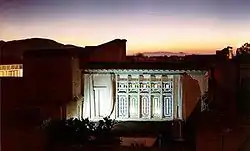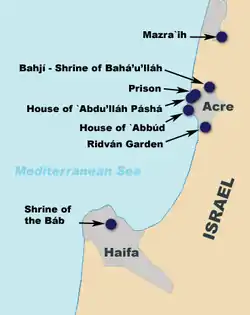Baháʼí pilgrimage
A Baháʼí pilgrimage currently consists of visiting the holy places in Haifa, Acre, and Bahjí at the Baháʼí World Centre in Northwest Israel. Baháʼís do not have access to other places designated as sites for pilgrimage.[1][2]

Baháʼu'lláh decreed pilgrimage in the Kitáb-i-Aqdas to two places: the House of Baháʼu'lláh in Baghdad, and the House of the Báb in Shiraz. In two separate tablets, known as Suriy-i-Hajj, he prescribed specific rites for each of these pilgrimages.[1] It is obligatory to make the pilgrimage, "if one can afford it and is able to do so, and if no obstacle stands in one's way". Baháʼís are free to choose between the two houses, as either has been deemed sufficient. Later, ʻAbdu'l-Bahá designated the Shrine of Baháʼu'lláh at Bahjí (the Qiblih) as a site of pilgrimage. No rites have been prescribed for this.[1]
The designated sites for pilgrimage are not accessible to the majority of Baháʼís, as they are in Iraq and Iran respectively, and thus when Baháʼís currently refer to pilgrimage, it refers to a nine-day pilgrimage that occurs at the Baháʼí World Centre in Haifa and Akká in Israel.[1] This nine-day pilgrimage does not replace pilgrimage to the designated sites for pilgrimage, and it is intended that pilgrimage to the House of the Báb and the House of Baháʼu'lláh will occur in the future.
House of Baháʼu'lláh, Baghdad

The House of Baháʼu'lláh in Baghdad, also known as the "Most Great House" (Bayt-i-Aʻzam) and the "House of God," is where Baháʼu'lláh lived from 1853 to 1863 (except for two years when he left to the mountains of Kurdistan, northeast of Baghdad, near the city of Sulaymaniyah). It was located in the Kadhimiya district of Baghdad, near the western bank of the Tigris river.[3] It is designated in the Kitáb-i-Aqdas as a place of pilgrimage and is considered a holy place by Baháʼís.[4]
In 1922[5] the house was confiscated by Shí'ih authorities, who were hostile to the Baháʼí Faith. The Council of the League of Nations upheld the Baháʼí's claim to the house, but it has not yet been returned to the Baháʼí community.[4][6]
The house was destroyed in June 2013, under circumstances that are currently unclear.[7] The Universal House of Justice sent a letter to all the National Spiritual Assemblies on 27 June informing them of the house's destruction.
House of the Báb, Shiraz


In this house in Shiraz, Iran, the Báb declared his mission to Mullá Husayn on 23 May 1844.[8]
In 1942-3 it was damaged by fire in an attack by enemies of the Baháʼí Faith, and in 1955 it was destroyed, but later again restored. In 1979 it was destroyed once more during the Iranian Revolution. In 1981 the site was made into a road and public square.[8]
Current nine-day pilgrimage

The places that Baháʼís visit on the current nine-day pilgrimage at the Baháʼí World Centre include the following.[9] (Baháʼí World Centre buildings contains additional information.)
Bahjí:
Haifa:
- Shrine of the Báb[12]
- Baháʼí Terraces[13]
- Arc
- Monument Gardens[18]
- Site of the future House of Worship[19]
- House of ʻAbdu'l-Bahá[20]
- Resting place of Amatu'l-Bahá Rúhíyyih Khanum[21]
- Pilgrim Houses:
Akká:
The nine-day pilgrimage is open only to Baháʼís and their spouses who have applied to go on pilgrimage.[9][29] Due to limited space at the Baháʼí holy sites, a maximum of 500 Baháʼís at one time are allowed to visit Haifa. Baháʼís have to wait up to six years to come and are only allowed to visit again after another five-year wait.[30]
Notes
- Smith, Peter (2000). "Pilgrimage". A concise encyclopedia of the Baháʼí Faith. Oxford: Oneworld Publications. p. 269. ISBN 1-85168-184-1.
- Linda Kay, Davidson; Gitlitz, David (2002). Pilgrimage, from the Ganges to Graceland: an Encyclopedia ABC-CLIO, Santa Barbara. ISBN 1-57607-004-2. pp. 48-50.
- The House of Baha'u'llah
- Smith, Peter (2000). "Baghdad: the House of Baháʼu'lláh". A concise encyclopedia of the Baháʼí Faith. Oxford: Oneworld Publications. pp. 66–67. ISBN 1-85168-184-1.
- Baháʼí International Community. House of Baha'u'llah seized.
- Toynbee, Arnold J. (1935). Survey of International Affairs 1934. London: Oxford University Press. pp. 120–122.
- "Sacred site in Baghdad destroyed". Baháʼí World News Service. 28 June 2013. Retrieved 28 June 2013.
- Smith, Peter (2000). "Shiraz: the House of the Báb". A concise encyclopedia of the Baháʼí Faith. Oxford: Oneworld Publications. pp. 314. ISBN 1-85168-184-1.
- Baháʼí World Centre (2007). "What is pilgrimage?". Baháʼí World Centre. Retrieved 10 August 2008.
- Baháʼí World Centre (2007). "Shrine of Baháʼu'lláh". Baháʼí World Centre. Retrieved 10 August 2008.
- Baháʼí World Centre (2007). "Mansion of Bahjí". Baháʼí World Centre. Retrieved 10 August 2008.
- Baháʼí World Centre (2007). "Shrine of the Báb". Baháʼí World Centre. Retrieved 10 August 2008.
- Baháʼí World Centre (2007). "Mount Carmel". Baháʼí World Centre. Retrieved 10 August 2008.
- Baháʼí World Centre (2007). "Universal House of Justice". Baháʼí World Centre. Retrieved 10 August 2008.
- Baháʼí World Centre (2007). "International Teaching Centre". Baháʼí World Centre. Retrieved 10 August 2008.
- Baháʼí World Centre (2007). "Centre of the Study of the Texts". Baháʼí World Centre. Retrieved 10 August 2008.
- Baháʼí World Centre (2007). "International Archives". Baháʼí World Centre. Retrieved 10 August 2008.
- Baháʼí World Centre (2007). "Monument Gardens". Baháʼí World Centre. Retrieved 10 August 2008.
- Baháʼí World Centre (2007). "Site of the Future Mashriqu'l-Adkhar". Baháʼí World Centre. Retrieved 10 August 2008.
- Baháʼí World Centre (2007). "House of the Master". Baháʼí World Centre. Retrieved 10 August 2008.
- Baháʼí World Centre (2007). "Resting place of Amatu'l-Bahá Rúhíyyih Khanum". Baháʼí World Centre. Retrieved 10 August 2008.
- Baháʼí World Centre (2007). "Haifa Pilgrim House". Baháʼí World Centre. Retrieved 10 August 2008.
- Baháʼí World Centre (2007). "10 Haparsim Street". Baháʼí World Centre. Retrieved 10 August 2008.
- Baháʼí World Centre (2007). "4 Haparsim Street". Baháʼí World Centre. Retrieved 10 August 2008.
- Baháʼí World Centre (2007). "Ridván garden". Baháʼí World Centre. Retrieved 10 August 2008.
- Baháʼí World Centre (2007). "House of ʻAbbúd". Baháʼí World Centre. Retrieved 10 August 2008.
- Baháʼí World Centre (2007). "House of ʻAbdu'lláh Páshá". Baháʼí World Centre. Retrieved 10 August 2008.
- Baháʼí World Centre (2007). "Mansion of Mazrai'h". Baháʼí World Centre. Retrieved 10 August 2008.
- Baháʼí World Centre (2007). "Baháʼí pilgrimage Frequently Asked Questions and Answers". Baháʼí World Centre. Retrieved 10 August 2008.
- Saul, Jonathan (27 November 2006). "World's Baha'i connect with past in Israel". Reuters. Retrieved 29 November 2020.
References
- Allen, Denny; Lesley Taherzadeh (2006). Baháʼí Pilgrimage. Oxford, UK: George Ronald. ISBN 0-85398-487-5.
- Baháʼu'lláh (1873). The Kitáb-i-Aqdas: The Most Holy Book. Wilmette, Illinois, USA: Baháʼí Publishing Trust. ISBN 0-85398-999-0.
- Denis MacEoin (1994). Rituals in Babism and Baha'ism. UK: British Academic Press and Centre of Middle Eastern Studies, University of Cambridge. ISBN 1-85043-654-1.
- Ruhe, David (1983). Door of Hope. Oxford, UK: George Ronald. ISBN 0-85398-150-7.
- Walbridge, John (1996). Sacred Acts, Sacred Space, Sacred Time. Oxford, UK: George Ronald. ISBN 0-85398-406-9.
Further reading
- Akerdahl, Per-Olof (2000), "Pilgrimage and Religious Identity in the Bahá'í Faith", Lights of Irfan, 1, Wilmette, IL: Irfan Colloquia, pp. 1–20
External links
| Wikimedia Commons has media related to Bahá'í institutions and facilities. |
